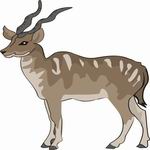- Antelope species can be found in parts of Africa, Asia, and the Middle
East
- Varies widely, from savanna to woodlands to marshes and swamps to
desert, depending on the species
- All antelope species have horns, although in some species they are
only found on the males.
- The horns are made of a bony core, encased in a hard material made
largely of keratin. They are permanently attached-not like a deer's
antlers, which are shed each year.
- Some antelope horns, like those of the kudu Tragelaphus sp. and eland
Taurotragus sp., twist in interesting spirals; others have ridges, like
those of the impala ]Aephyceros melampus and the sable antelope Hippotragus
niger; and others grow in wide curves with a sharp point on the end,
like those of the wildebeest Connochaetes sp. (also called the gnu,
a name it gets from its call, which sounds like "ge-nu").
- Antelope use their horns in defense against predators; males and
sometimes females also use them to establish their position in a herd
or to fight rivals
- Hooves are another specialty for many antelope. Each hoof has a split
down the middle, dividing the hoof into two "toes." Because
they live in wetlands and swamps, sitatungas Tragelaphus spekeii have
wide hooves up to 7 inches (18 centimeters) across that help them walk
on mud and mats of plants without slipping.
- We tend to think of antelope as living in big groups, but not all
species form large herds. Some antelope are famous for their massive
herds, like the thousands of wildebeest making their annual migration
across the African plains. Others, like duikers Cephalophus sp., bongos
Tragelaphus euryceros, dik-diks Madoqua sp., and sitatungas, live alone,
in pairs, or in small groups of between 3 and 10 animals.
- The social life of antelope depends a lot on the type of habitat they
live in and how much food and water is available.
- Some antelope species, like impalas, springboks Antidorcas marsupialis,
and saigas Saiga tatarica form very large herds during migratory seasons
when they are on the move to find the best food.
- The males are not usually territorial at these times, but they may
separate out during the breeding season and stake out a territory where
they compete for females.
- They may also use size or strength displays or threaten with their
horns to determine who's dominant and to keep females.
- Many antelope that live in large groups at least part of the year
also have special scent glands on their hooves, so they leave the herd's
scent on the ground for any stray members to find.
- In territorial species like sable antelope, oryx Oryx sp., waterbuck
Kobus ellipsiprymnus, bontebok Damaliscus pygargus, and gazelles, the
males choose a particular piece of habitat and defend it from other
adult males.
- Herds of females and their young can come and go freely, although
in the breeding season the male will try to keep them in his territory.
- Antelope are herbivores, with an odd exception: some species of duikers
have been known to kill and eat insects, small mammals, and birds. Otherwise,
antelope tend to be either browsers or grazers. Some species switch
back and forth, eating whatever is most nutritious or what's available
during dry or cold times of the year.
- Some antelope have special feeding adaptations for their environments.
Addaxes Addax nasomaculatus know to follow the rains, traveling great
distances to eat the new plant growth. Thomson's gazelles Gazella thomsonii
follow herds of migrating wildebeest and zebras, which eat the tougher
layer of grasses and leave the shorter, more tender shoots behind. Perhaps
two of the oddest-looking antelope are the gerenuk Litocranius walleri
and the dibatag Ammodorcas clarkei, both of which have slender bodies,
long thin legs, and very long necks. They can stand upright on their
hind legs and stretch up with those long necks to eat leaves that other
species can't reach!
- Antelope calves have two survival strategies: either they hide out
to avoid predators, or they start traveling right after birth so they
can join the protection of the herd. The majority of antelope use the
hiding approach, like elands, greater kudu Tragelaphus strepsiceros,
roan antelope Hippotragus equinus, waterbucks, klipspringers, and duikers.
- In species that migrate or live in large ranges, like the hartebeest
Alcelaphus buselaphus, topi Damaliscus lunatus, bontebok, and wildebeest,
the calves are up and on their feet within a few minutes to a day or
so after they are born, and they immediately start traveling with the
herd. They often stick together as a group and are protected by adults
surrounding them. This way they don't get left behind and can nurse
from their mothers. If danger approaches, the adults can face the challenge
with their strength and their horns.
|


